Is Poverty Being Underestimated in India?
Published On:

Definition of Poverty in India
Poverty in India has historically been defined based on the expenditure required for sustaining a minimum calorie diet. Earlier, this threshold was updated periodically using data from national surveys. However, the methodology evolved over time, incorporating data on consumption expenditure to better reflect household realities. Despite these updates, debates continue on the adequacy of current definitions, especially in the context of a shifting socio-economic landscape.
Concerns with the Household Consumption Expenditure Survey (HCES)
The HCES collects data to assess consumption patterns and poverty levels. However, several issues arise:
- Periodic Changes in Methodology: The method for data collection has been modified over time, causing inconsistencies in results. For example, changes in reference periods and data collection formats have led to differences in expenditure patterns being recorded.
- Exclusion of Key Factors: The absence of regular surveys on official poverty estimates has created gaps in understanding multidimensional aspects of poverty.
Methodological Changes and Implications
The recent survey used a new methodology, which diverged from earlier approaches by measuring consumption through different recall periods and adjusting for inflation. Although this has improved accuracy, it raises concerns:
- Incomplete Comparisons: Updated methods do not align seamlessly with older data, limiting the ability to draw historical comparisons.
- Impact on Estimates: The changes led to a decline in recorded poverty levels, but critics argue that the figures may understate the true extent of deprivation.
Urban and Rural Poverty Trends
The data reveals disparities between rural and urban poverty levels:
- Rural Areas: Improvement in rural poverty levels can be attributed to rising wages and better access to services. However, rural populations still face issues such as underemployment and lack of diversification in livelihoods.
- Urban Areas: Urban poverty levels remain stagnant due to rising costs of living and inadequate public services, which disproportionately affect lower-income groups.
Relevance of the Poverty Line
The poverty line plays a crucial role in policy decisions but has faced criticism:
- Low Threshold: Existing poverty lines are often considered too low to reflect the realities of deprivation, especially in urban areas.
- Need for Revision: A revised poverty line that considers a broader set of indicators, such as health, education, and housing, is necessary for a more accurate understanding of poverty.
Challenges with Multidimensional Poverty Indices
Multidimensional measures of poverty, such as indices proposed by international agencies, aim to capture broader aspects of deprivation. However:
- Contextual Limitations: These indices may not fully reflect local realities, as they are often designed for global comparisons.
- Customisation Needed: For India, there is a need to include indicators such as access to public goods and social security in these frameworks.
Policy Implications
- Revisiting Methodologies: There is a need for consensus on the poverty line and data collection methodologies to ensure accurate estimations.
- Focus on Public Interventions: Policies must address gaps in health, education, housing, and access to basic services to tackle the root causes of poverty.
- Urban-Rural Balance: Equal attention should be given to improving conditions in both urban and rural areas, focusing on targeted interventions for vulnerable groups.
Conclusion
Understanding and addressing poverty requires a nuanced approach that goes beyond income measures to include multidimensional aspects. A robust and updated methodology, aligned with contemporary realities, is crucial for devising effective policies to reduce poverty in India.
